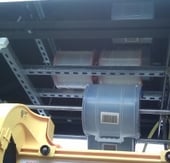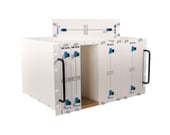This year’s OFC conference in San Diego will be another showcase of innovative new and future technologies. With fiber optic communication and networking equipment continuing to evolve, testing procedures and setups must also grow and change as part of the process. Engineers are then often faced with a challenge - how can they continue to add and integrate new systems and the appropriate connectivity infrastructure in a finite amount of lab space? While some may benefit from new facility expansions, the luxury of additional square footage and rack space isn't often the case for most.
Simply put, the test lab has to become as efficient as possible. Much like a truck being loaded with shipments, every inch of space must be used as effectively as it can. One area of opportunity to save valuable space is by managing spools of optical fiber used for simulating optical links and delays in a more efficient manner.
Over the years, many engineering departments simply utilized unsecured optical fibers on the original factory spools shipped from the manufacturer. Not only can this approach lead to unreliable results and broken fibers, it is also a very poor use of lab space as the physical spools take up a lot of real estate especially when many are involved. While most network equipment is stored in rows and rows of racks, spools of optical fiber are not always managed and stored in that same manner. This means additional time and effort to find the right spools for testing and the general hassle of dealing with bare fiber, all while taking up more space than necessary.
 |
Picture: Optical fiber spools stored in original shipment packaging
|
Save Valuable Space and Improve Testing Results
To greatly minimize the issue of optical fibers requiring too much space, adopting a professionally packaged optical fiber approach not only guarantees physical space savings in the lab, but provides added benefits of fiber protection and reliable performance results. In many instances, utilizing a solution like a Fiber Lab from M2 Optics will reduce the physical space requirements in the lab by as much as 50% or more versus using an original factory spool approach. Not only do these solutions save space and make life easier for engineering teams, but fully-customized setups result in maximum value and exact simulation of link performance and/or optical time delays as required.
For those currently struggling to better manage their fiber spools or needing to add more fiber into a limited amount of lab space, Fiber Lab solutions coupled with M2's specialized manufacturing expertise provides a proven approach that is trusted by leading entities around the world.
Contact M2 Optics today to discuss how to best optimize your optical fiber setup or to design an efficient, customized solution for your fiber network simulation or time delay testing application.






